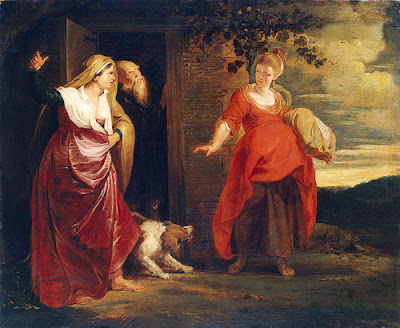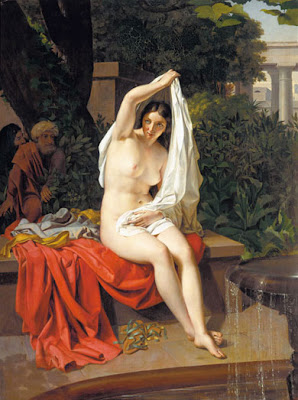Sometimes I’m asked what nudes got to do with religion. If we talk about Christian religion, not much I think. But here I want to talk about art and for art nudes are very important. The problem was (and is) the hypocrisy of society. Painting nudes could be a good business, but simple nudes were not considered as art but a scandal.

In the good old times an artist who wanted to paint nudes to make a living had only three possibilities: classical goddesses (Venus, Aphrodite etc.), oriental women (Odalisques) or biblical subjects.
So the normal biblical nude pretended only to be a religious painting. Actually it was a lame excuse to sell nudes. That this was a common practice is shown by the caricature by Honoré Daumier from 1864. Visiting the yearly exhibitions of the Paris Salon with all that nudes sold as classical goddesses two women are lamenting scandalized: "This Year Venuses Again… Always Venuses!"
Another example is the French painter Édouard Manet (1832–1883), who is often considered as one of the most important fathers of modern painting. Manet was planning a painting about the finding of Moses and made therefore studies of Pharaoh's Daughter inspired by the painting "Susanna bathing" by Rembrandt.

Rembrandt: Susanna bathing (ca.1636)
The first result was another Susanna know by Manet.

In 1861 during a visit in Russia he wanted to sell this painting, but thought that the very religious Russians would prefer to buy a classical nude. So he added a satyr and called it "nymph surprised" (instead of Susanna surprised). When he couldn’t sell it, he covered the satyr, and so it can be seen today in Buenos Aires.
Probably tired of that hypocrisy of the art market he painted in 1862 the most famous of his works: Le déjeuner sur l'herbe (The Luncheon on the Grass). Sure that it was influenced by paintings by Raphael and Titian, but I think that there are still two men with the nude women, which reminds me of Susanna and the elders.

Anyway it caused a great scandal, art critics called it "immoral" and "vulgar" because there were normal nudes to be seen (not half as voyeuristic as many of the neoclassical goddesses). But this was the point, that there was no Bathsheba, no Susanna, no Venus or Diana, just normal, human nudes. The jury refused to expose the painting in the Paris Salon, which was the cause of the formation of the impressionist movement.
So in short: I don’t want to write about religion, but about the tricks in art. And because religion provided art with a lot of subjects, tricks and excuses I write about that interpretations.













.jpg)












